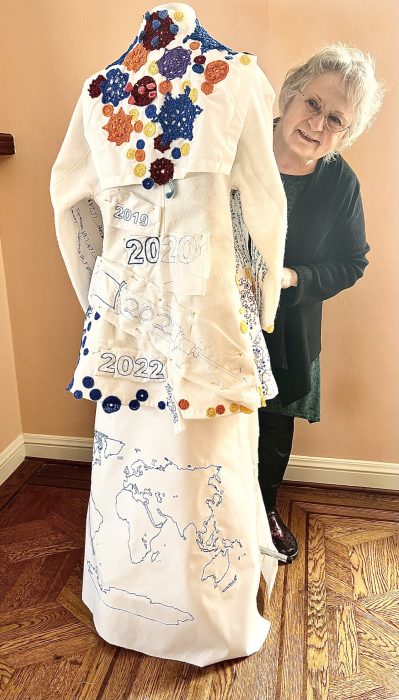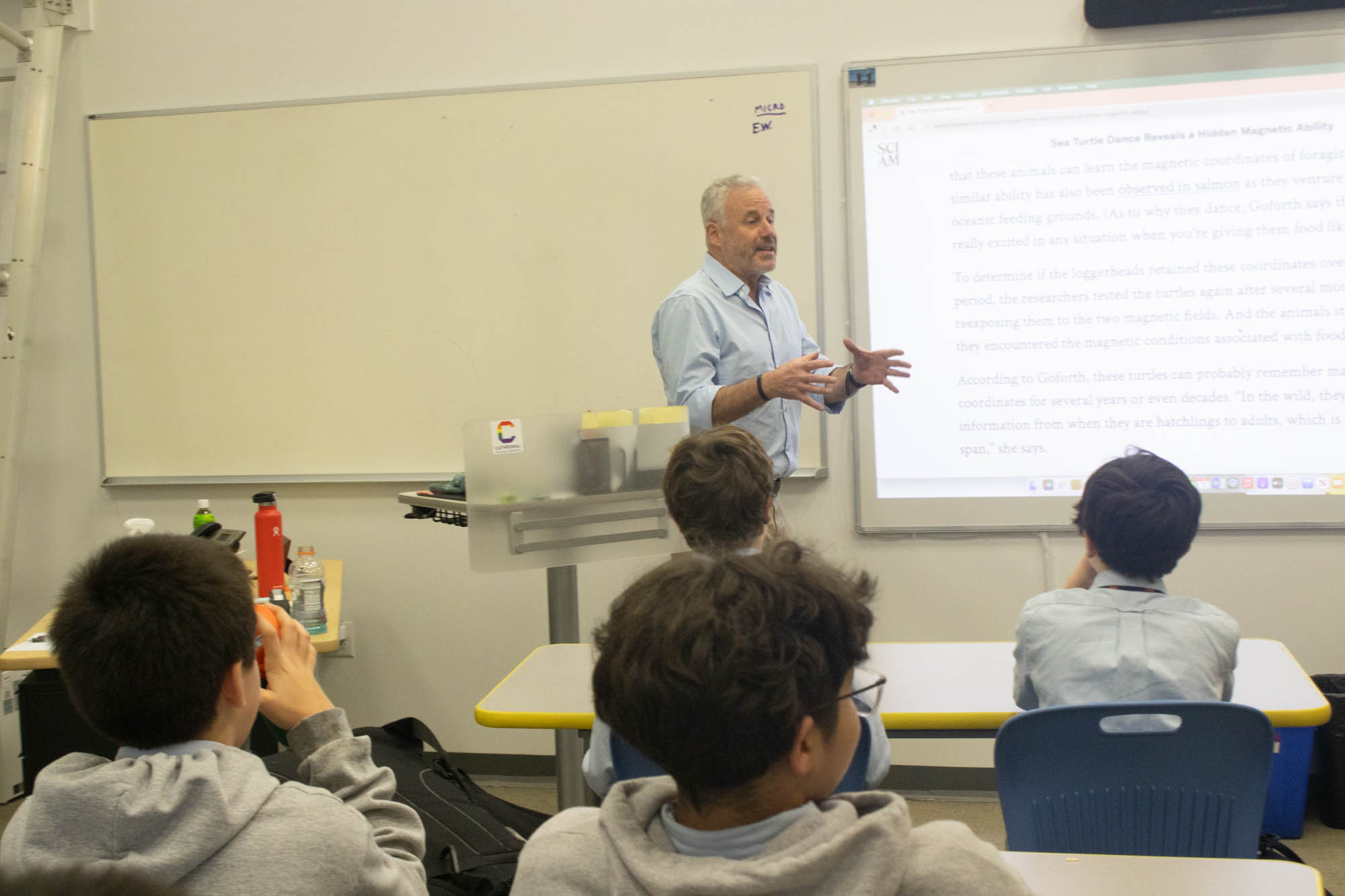Buttons, strings and fabric scraps: Artist creates intricate designs and portraits from bits and pieces
Marie Bergstedt finds art in the everyday: buttons, fabrics, bits of discarded clothing, and string. She combines those mundane materials into expressive representations of a person she’s known or observed. Her subjects range from relatives, friends and associates to street people.
A self-described fabric artist, she works with natural and synthetic fibers to create her pieces. Most become wall hangings. The rest take shape in varied configurations – from full-length gowns to colorfully decorated old telephones to portraits made with buttons.

“I am not a typical fiber artist,” Bergstedt said in an interview in her Portola neighborhood home. The cheerful, 78-year-old grandmother laughs as she recounts her life’s ups and downs, and the relationships that have inspired her creations.
Hand skills and healing
She’s wanted to be an artist all her life, but grew up “poor and practical,” she said. Still, she made her first sale – crocheted doilies sold to relatives – at age 8.
She learned crocheting, knitting, embroidering, stitching, and sewing in childhood – on her own and from an aunt. Other skills, like photography, which she also uses in her art, came from various classes she took as an adult. It wasn’t until her 60s that she realized working with fabric would become the center of her an artistic career.
Bergstedt spent years working as a kindergarten teacher and fundraiser. But in 2005, at the age of 61, she became a full-time artist and has compiled an impressive history here and abroad. She’s won 28 awards and has had more than 100 juried or curated. She had several invitational showings in the Bay Area and four other states.
Famous overseas
But she’s better known abroad from exhibitions in China, Canada, Madrid, and Venice. “My art is more accepted internationally; it isn’t a big seller here and it’s hard to get a gallery show.” Fiber art, she said, is often sneered at in the U.S., seen as a lower form of art, or even “women’s work.”
Her technique is unusual, even in the small world of fiber artists. “I use a lot of different stuff. Most other (fiber artists) don’t.” Her intricate use of buttons sets her apart as well, she said. “Lots of people use them but not the way I do. I do more detailed things with buttons. I shape them. The face and eyes are buttons; they are dimensional.”
One of her largest wall hangings, “Gentle Men on the Street,” has gotten the most attention. It first appeared in 2021 during an online version of the prestigious The 11th From Lausanne to Beijing International Fiber Art Biennale. It is featured in the latest issue of Fiber Art Now magazine, one of more than 40 publications that have highlighted her work.

It shows two nearly life-size men relaxing inside two large picture frames. Their faces are buttons, as are their feet and hands. The piece is a memorial to her brother Mikey and his best friend Thomas. Both were street musicians and urban campers in Key West, Florida, for many years before they died. “Unframed by accepted norms, they found a place in the culture at the farthest south point in the United States,” Bergstedt wrote on her website.
Gentle Men demonstrates her range of skills and materials: hand-stitching, embroidery, knitting, and crocheting over needlepoint canvas. The piece utilizes cotton, polyester, nylon, eco-felt, recycled clothing and buttons with eco-felt backing and wooden stretcher frames.
Art with a story
She hopes when viewers see her work, they will be moved to reflect on their own experiences. Each of her pieces, she said “has a story behind it.”
Bergstedt’s early story was driven by her limited finances.
She won a full scholarship to Wheaton College in Illinois, but rather than studying her favorite subjects – math and science — she opted for the security a teaching degree might bring. She was, though, inspired by the teacher of the one art class she took. At graduation, she felt a hand on her shoulder. It belonged to the art teacher.
“‘My dear,’” Bergstedt said, quoting the teacher. ‘“You have missed your calling. You must always study and make art whatever else you do.’”
It was advice she never forgot.
Bergstedt married and taught kindergarten until her husband’s job moved them around the country. She took art classes and workshops at every opportunity.
During extended lulls between moves, she studied photography, first at Wright State University in Dayton, Ohio, then at the San Francisco Art Institute. With her new expertise, she made hand-colored photos meant to tell the stories of her youth. She still incorporates photography in her work. “It was satisfying but it was not using fiber materials,” she said.

Her marriage ended, and as a single mother with a young daughter, she worked 25 years in fundraising for a range of nonprofits. To follow her dream of becoming a full-time, independent artist, she skimped and saved until she had enough to switch careers. “Oh, it was tight,” she said with a laugh.
In 2006, when she was 60, she found a fiber sculpture class at the College of Marin “where my creative ideas could blossom.” She was looking for a way to surface the hidden stories she wanted to tell. “That came when I started using buttons (for) what I was trying to reveal.”
One such piece is “Clara,” named after her foster mother, who raised 72 foster children in her lifetime. “Clara took great joy, and received the power she needed to master life’s challenges, through communication by telephone, right on through her 100th birthday and until her death in 2008,” Bergstedt wrote on her website.
Honoring family
The piece is composed of buttons, glass beads, embroidery floss, needlepoint canvas, and wire. To honor Clara’s devotion to the telephone, Bergstedt created seven richly encrusted telephones. One is based on the Western Electric #317 magneto wall phone introduced in 1907, made of design of antique and new cotton crochet with button work over wire armature.
Another piece is of her aunt Terry, depicted as a button face with blue eyes and ruby-red lips, next to a broken bass fiddle. Her aunt, whose full name was Thelma Combes, played first-chair bass in the Chicago Women’s Symphony before moving to the role of lone female bassist, vocalist and leader in popular jazz bands during the 1920s. Leading an all-male band in that era, her aunt contended with sexism, Bergstedt said, and it destroyed her career.
“Aunt Terry was way ahead of others in breaking the boundaries of female leadership,” Bergstedt said, “but her life lived out as both an inspiration and a tragedy.”
“Terry” was voted the favorite of the 2016 Pittsburgh Center for the Arts Fiber Art exhibition.

One of the most riveting of Bergstedt’s pieces is “Breathe,” showing a woman in a purple dress on life support. She’s lying down, a coffin on one side of her, a sleeping bag on the other.
“I am living the story that almost everyone I know does not acknowledge,” Bergstedt wrote. “Millions of us are entering old age and, for the first time, we must face the inevitable shift, from lively health to death. And, especially for women, this is often a challenge we face alone.”
Now Bergstedt is finishing another piece: a white gown with colorful embroidery that includes images of COVID-19 cells and a map of the world. And she just finished another, virus-themed piece, “Six Feet Apart,” that’s headed to Riga, Latvia.
“My aim is to engage viewers in thought,” Bergstedt said. “Maybe they will find their own stories through images. Perhaps they will find my work disturbing. It is fine if they get angry or maybe laugh. I hope some of my work will encourage people to follow a calling that before seemed impossible.”






sharron butler
Great article. Again tells a story of you just like your art. I'm happy for you. You have worked so hard to get here.
Laverne Simon
Does Marie ever sell her art to the public? What is her website?
Doug
Really well written article and a very interesting subject. She seems at peace with the world.